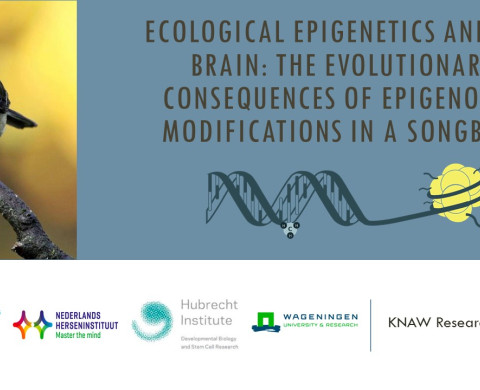Ecological epigenetics and the brain: the evolutionary consequences of epigenomic modifications in a songbird

This unique inter-disciplinary collaboration between three of the larger institutes of the KNAW aims to elucidate the function of epigenetic regulation in the great tit brain to be able to study its role for the evolution of behaviour. Epigenetic mechanisms, such as DNA methylation and histone modification, are key epigenetic mechanisms that can alter gene expression, thereby affecting behavioural variation, both short- and long-term. While we know that epigenetic mechanisms act on different time scales and may be expressed in different tissues or brain regions, an essential gap in our knowledge is: how do epigenomic alterations contribute to fitness variation and what is their role in the evolution of behavioural traits?
To be able to answer this research question, we will obtain detailed information on the epigenetic processes underlying behavioural traits in a species where we can measure the fitness consequences in a natural environment, the great tit (Parus major). Our knowledge of epigenetic mechanisms underlying behavioural traits in wild vertebrates are limited to few studies on DNA methylation (see e.g. Verhulst et al. 2016; Derks et al. 2016), thus severely hampering the field of ecological behavioural epigenetics. Furthermore, some of the more relevant epigenetic signatures that explain how tissues behave intrinsically as well as in response to the environment do not necessarily involve DNA methylation but are rather governed by histone modifications. Our main objective is to translate the knowledge from the seminal work done in model organisms and convert this to an ecological model species to be able to study the ecological and evolutionary consequences of epigenomic alterations.
To achieve this objective, we will
- measure DNA methylation and histone acetylation in specific brain regions, such as specific parts of the cerebellum, cerebral cortex and basal ganglia (see below) and relate this to variation in a range of simple to complex behavioural traits, from motor behaviour to complex learning tasks in great tits.
- validate the link between epigenetic marks and behaviour in the mouse and the rat, thereby assessing the actual causal links between epigenetics and behaviour in specific brain regions.
- link this to fitness measures in a natural population to measure the potential for evolutionary changes in behaviour due to underlying epigenetic variation.
Experts
-

-
Beril Yildiz
Bio-informatician , Animal Ecology -
Krista van den Heuvel
PhD Candidate , Animal Ecology
